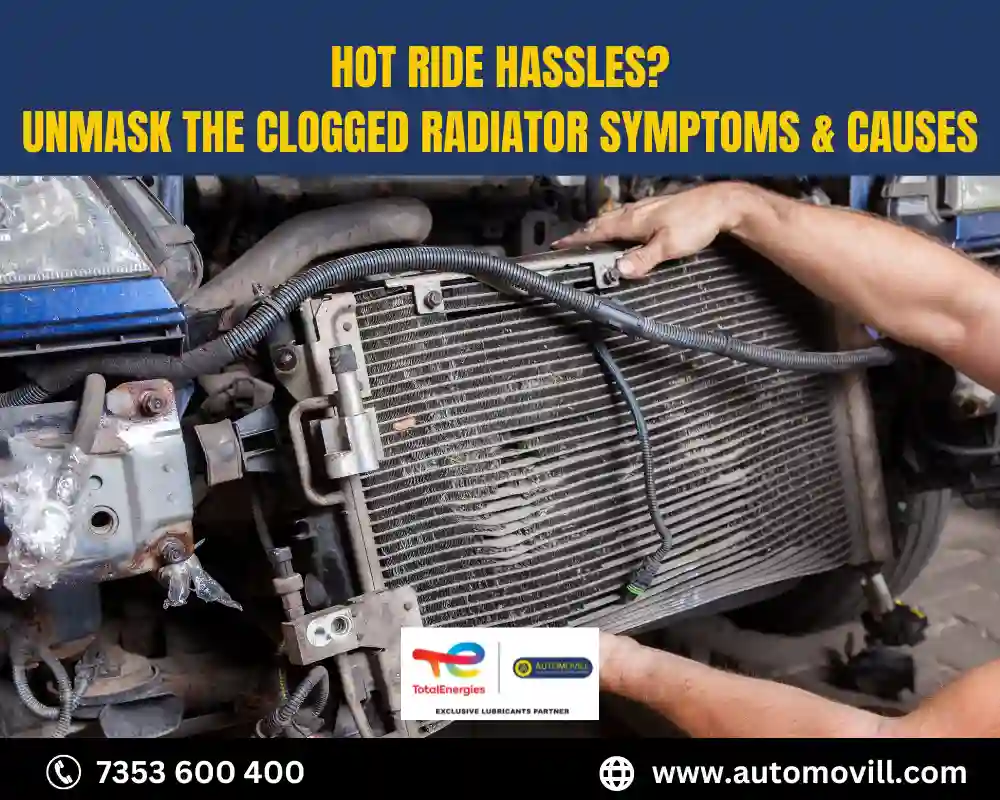
Hot Ride Hassles?
This could be a possibility of a clogged radiator, which happens due to several reasons such as debris collection, rusting, etc.
The radiator is the most important part of your car’s cooling system to regulate the temperature of the engine.
In this article, we’ll discuss the symptoms and causes of a clogged radiator and also prevention tips.
Symptoms of a Clogged Radiator
1. Temperature Gauge on the Rise
One of the initial indicators of a clogged radiator is an elevated temperature gauge on your dashboard. If you notice the needle creeping toward the red zone, it’s time to investigate.
2. Engine Overheating
A clogged radiator will not allow the coolant to flow and as a result, the engine to overheat, leading to reduced performance, potential damage to engine components, and even complete breakdowns.
3. Warm Air From AC Vents
If the radiator is clogged then it not only causes engine overheating but also affects AC performance as well because the radiator is used by both the engine coolant and the air conditioning system.
For a better understanding you can refer to this article Can a Clogged Radiator Cause AC Not To Work?
4. Coolant Leaks
There are many signs and causes of coolant leaks such as head gasket failure, water pump issues etc. Insufficient coolant circulation due to a clog can lead to pressure buildup, resulting in leaks from various points in the cooling system.
5. Low Coolant Levels
If you find yourself frequently adding coolant, there’s a possibility that a clogged radiator is preventing the proper circulation of coolant.
6. Smoke Under Hood
If the engine gets hotter than it should be then you may notice the smoke under the hood which can also be another sign of a clogged radiator. If you notice such a sign then you must immediately turn off the engine to prevent the damage.
7. Sluggish Performance
A hot engine can cause your vehicle to feel sluggish or unresponsive. This symptom is particularly noticeable during acceleration or when climbing steep hills.
Causes of a Clogged Radiator
1. Gathering of Debris
Dust, dirt, and other debris can accumulate on the radiator fins over time, restricting airflow. This buildup gradually reduces the radiator’s cooling efficiency.
2. Rust and Corrosion
Over time, the metal components of the radiator can corrode, leading to the formation of rust particles. These particles can clog the radiator and impede coolant flow.
3. Scale and Mineral Deposits
In areas with hard water, mineral deposits can accumulate within the radiator, forming a layer of scale that obstructs the flow of coolant.
4. Contaminated Coolant
Using the wrong type of coolant or neglecting regular coolant changes can result in a mixture that forms sludge or deposits within the radiator.
5. Coolant Additives Breakdown
While coolant additives are designed to prevent corrosion and scale buildup, they can break down over time, allowing particles to settle in the radiator.
How To Check Whether Radiator is Clogged Or Not?
To test for a clogged radiator, one can drain the radiator and observe the flow of the coolant, which should be consistent. If the coolant is flowing slowly or inconsistently, the radiator is likely clogged.
Rust in the cooling system can also cause clogging of the radiator and heater core. Using the correct coolant designed for the vehicle can prevent corrosion buildup and clogging of the radiator.
Another way to test for a clogged radiator is to warm up the engine with the radiator cap off and observe the coolant flow. If the flow is not consistent, the radiator is likely clogged.
Prevention and Maintenance
- Coolant Flush: Follow your vehicle manufacturer’s recommended coolant flush intervals to prevent the buildup of debris and contaminants.
- Use Distilled Water: When mixing coolant, use distilled water to minimize the risk of mineral deposits forming in the radiator.
- Visual Inspection: Regularly inspect your radiator for visible signs of debris or corrosion, and clean the fins gently if needed.
- Quality Coolant: Always use high-quality coolant recommended for your vehicle, as it contains additives that help prevent clogs and corrosion.
- Protective Cover: Consider using a grille cover in winter to reduce the amount of debris that can accumulate on the radiator.
Conclusion
A clogged radiator can lead to engine overheating and reduced performance which may lead to further damage to several engine components. If you understand the symptoms early and address the causes, you must take your car to the reputed workshop to rectify the issue and prevent further damage.
Regular service and prompt attention to any issues can go a long way in ensuring your vehicle’s longevity and performance.
